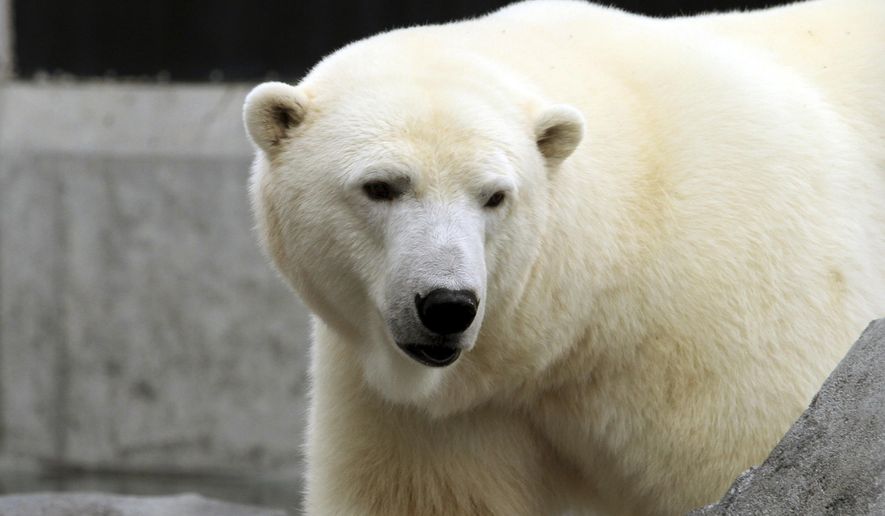The Obama administration warned Monday that polar bears may disappear unless something is done about climate change, despite recent research indicating that the bears are actually thriving.
In its final Conservation Management Plan, the Fish and Wildlife Service painted a grim picture for the future of the massive Arctic-dwelling mammal, warning that its fate will be determined “by our willingness and ability to address climate change.”
“The current global polar bear population is estimated to be 26,000,” said the Fish and Wildlife Service. “If greenhouse gas emissions continue to rise at the current rates throughout the 21st century, polar bears will likely disappear from much of their present-day range.”
The announcement prompted pushback from zoologist Susan J. Crockford, founder of the Polar Bear Science website, who blasted the service for igniting a rash of “sensationalized nonsense” by fueling alarmist media reports.
Since 2007, “summer sea ice coverage has declined to levels their sea ice colleagues said would not occur until 2050 yet 2/3 of the world’s polar bears did not disappear as [U.S. Geological Service] biologists predicted,” Ms. Crockford said in a post.
The polar bear was listed as threatened in 2008 as a result of declining Arctic sea ice, but its population has proved remarkably resilient, although the Fish and Wildlife Service plan doesn’t mention that, she said.
PHOTOS: Top 10 handguns in the U.S.
“They also don’t tell folks that the recent decline in population size recorded for the Southern Beaufort Sea was caused by thick spring sea ice in 2004-2006, not reduced summer sea ice,” said Ms. Crockford, an adjunct professor at the University of Victoria in British Columbia.
The International Union for Conservation of Nature pegs the polar bear population at between 22,000 and 31,000, which she called “the highest estimate in 50 years.”
Studies have shown increases in some of the 19 Arctic polar-bear populations. In 2013, the FWS reported the Chukchi Sea population in Alaska was doing “quite well,” while the Norwegian Polar Institute found in 2015 that the Barents Sea polar bears had risen by 42 percent since 2004.
Meanwhile, wildlife groups criticized the federal plan for failing to mandate large-scale U.S. reductions in greenhouse-gas emissions in order to combat climate change.
“Polar bears are starving and drowning as their sea ice melts away, but this toothless plan shrugs off the one solution that will save them — carbon pollution cuts,” said Shaye Wolf, climate science director at the Center for Biological Diversity.
The center said the administration should have required “reductions in other important threats to the polar bear: oil and gas drilling, increasing Arctic shipping, and contaminants.”
PHOTOS: Best NFL quarterbacks of all time — ranked
Instead, the final order calls for “reducing human-bear conflicts, collaboratively managing subsistence harvest, protecting denning habitat, and minimizing the risk of contamination from oil spills,” said the service.
“Most of these actions are already under way, in partnership with Alaska Native communities, nonprofit groups, and industry representatives who participated in the plan’s creation,” the Fish and Wildlife Service said. “The plan also calls for increased monitoring and research to determine whether the actions in the CMP are being effective or need to be modified.”
The final plan was released in a flurry of environmental actions issued in the final weeks of President Obama’s tenure. Critics have slammed the actions as parting shots aimed at hamstringing the incoming Trump administration.
“Perhaps it’s not a coincidence that this old hype is being recycled as ’news’ prior to the inauguration of President-elect Trump?” asked Ms. Crockford, author of “Polar Bears: Outstanding Survivors of Climate Change.”
The Fish and Wildlife Service stressed that its prescriptions are short-term fixes aimed at helping “this revered symbol of the Arctic persist in the wild in the near term, while also acknowledging the primary threat to the bear will entail longer-term actions.”
“This plan outlines the necessary actions and concrete commitments by the service and our state, tribal, federal and international partners to protect polar bears in the near term,” said Greg Siekaniec, the service’s Alaska regional director. “But make no mistake — without decisive action to address Arctic warming, the long-term fate of this species is uncertain.”
• Valerie Richardson can be reached at vrichardson@washingtontimes.com.




Please read our comment policy before commenting.